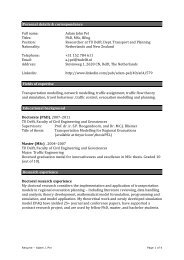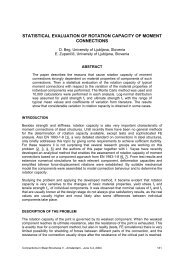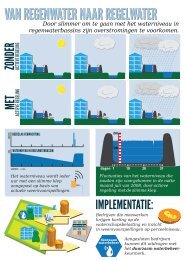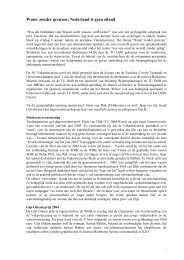Pedestrian route-choice and activity scheduling theory and models
Pedestrian route-choice and activity scheduling theory and models
Pedestrian route-choice and activity scheduling theory and models
You also want an ePaper? Increase the reach of your titles
YUMPU automatically turns print PDFs into web optimized ePapers that Google loves.
S.P. Hoogendoorn, P.H.L. Bovy / Transportation Research Part B 38 (2004) 169–190 179<br />
<br />
<br />
Z Ti<br />
<br />
v ½t;T i Þ ¼ arg minC i t; ^x; v ½t;Ti Þ; fA ij g ¼ arg minE Lðs; xðsÞ; vðsÞÞds þ /ðT i ; xðT i ÞÞ ð17Þ<br />
where L <strong>and</strong> / are given by Eqs. (8) <strong>and</strong> (7) respectively. To solve the path <strong>choice</strong> problem, let us<br />
define the so-called expected minimum perceived disutility function W ðt; ^xÞ (often referred to as the<br />
value function in optimal control <strong>theory</strong>) by the expected value of the costs upon applying the<br />
optimal velocity v ½t;T i Þ<br />
Z Ti<br />
<br />
W ðt; ^xÞ :¼ E Lðs; x ðsÞ; v ðsÞÞ þ /ðT i ; x ðT i ÞÞ<br />
ð18Þ<br />
subject to<br />
t<br />
dx ¼ v dt þ rðx ; v Þdw subject to x ðtÞ ¼^x<br />
To derive the dynamic programming equation, consider the period [t; t þ h). According to BellmanÕs<br />
optimization principle (Bellman, 1957), we have<br />
Z tþh<br />
<br />
W ðt; ^xÞ ¼E Lðs; x ðsÞ; v ðsÞÞ þ W ðt þ h; x ðt þ hÞÞ<br />
ð20Þ<br />
t<br />
Eq. (20) describes that the expected minimal cost of walking from ðt; ^xÞ to A ij equals the minimal<br />
expected cost of both walking from ðt; ^xÞ to ðt þ h; x ðt þ hÞÞ <strong>and</strong> walking from ðt þ h; x ðt þ hÞÞ to<br />
A ij . For small h, the following approximation is valid<br />
Z tþh<br />
<br />
E Lðs; xðsÞ; vðsÞÞ ¼ Lðt; xðtÞ; vðtÞÞh þ Oðh 2 Þ<br />
ð21Þ<br />
t<br />
The r<strong>and</strong>om variate xðt þ hÞ describing the predicted location at instant t þ h subject to Eq. (4)<br />
can be exp<strong>and</strong>ed using a Taylor series<br />
p<br />
xðt þ hÞ ¼^x þ hvðtÞþr<br />
ffiffiffi<br />
h w þ Oðh 3=2 Þ<br />
ð22Þ<br />
where rh 1=2 w is a Nð0; hrr 0 Þ distributed r<strong>and</strong>om variate. We can rewrite the expected value of the<br />
second term of the right-h<strong>and</strong>-side of Eq. (20)<br />
E½W ðt þ h; xðt þ hÞÞŠ ¼ W ðt þ h; ^x þ hvÞþ h X<br />
H ij ðx; vÞ o2 W ðt; ^xÞ<br />
þ Oðh 3=2 Þ ð23Þ<br />
2<br />
ox i ox j<br />
where Hðx; vÞ :¼ rðx; vÞr 0 ðx; vÞ. Substitution of Eqs. (21) <strong>and</strong> (23) into Eq. (20), using the appropriate<br />
Taylor series expansions, <strong>and</strong> taking the limit h ! 0 yields the so-called Hamilton–<br />
Jacobi–Bellman (HJB) or dynamic programming equation for decision making in continuous time<br />
<strong>and</strong> space under uncertainty<br />
o<br />
W ðt; xÞ ¼Hðt; x; rW ; DW Þ<br />
ot ð24Þ<br />
with terminal conditions<br />
W ðt 1 ; xÞ ¼/ i<br />
ð25Þ<br />
ij<br />
t<br />
ð19Þ

















